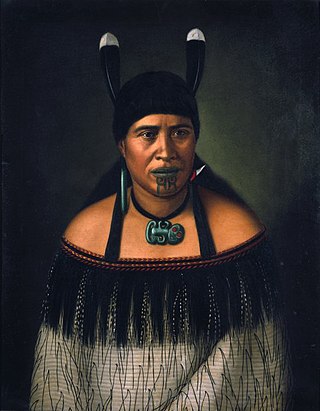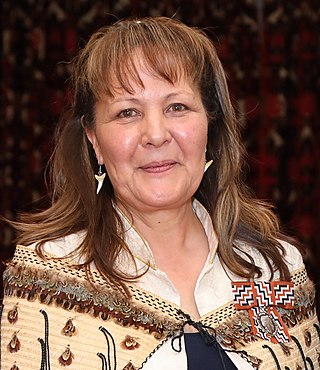Josephine Mulvany and Sybil May Mulvany were New Zealand weavers. They established the first commercial hand weaving studio in New Zealand. A large quantity of their work is held at Te Papa, in Wellington and the Auckland War Memorial Museum.
Josephine Mulvany and Sybil May Mulvany were New Zealand weavers. They established the first commercial hand weaving studio in New Zealand. A large quantity of their work is held at Te Papa, in Wellington and the Auckland War Memorial Museum.
Josephine Mulvany was born on 7 May 1899 and Sybil Mulvany was born on 6 March 1901. Both sisters were born in Parnell, Auckland to parents Thomas John Mulvany and Mary Reilly. In 1909 they were part of the first intake of students at Baradene College of the Sacred Heart, a Catholic boarding school. Their mother died of uterine cancer in 1912 but left money for her children to finish their education. Their father died in 1916 leaving them the family property. [1]
After finishing school Josephine found employment at a photography studio in Auckland and Sybil trained as a nurse.
In 1926 the sisters left for the United Kingdom. They spent a year touring around England, Ireland, France and Italy in a new Renault open tourer. For two women to travel without a chaperone was quite significant in the 1920s. The following year they began a three-month course at the London School of Weaving. After graduating they purchased looms and other equipment required for starting a hand weaving studio and returned to New Zealand.
In 1928, they opened their first studio 'Taniko Weavers' in New Castle, Auckland. The name, Tāniko, refers to the traditional Māori method of weaving however, the weaving produced by the sisters contained no Māori influences. The next year the sisters moved their business to a larger more central location on Darby Street. The second studio had two storeys, allowing for a shop on the first level and a separate workspace of 6 looms on the second. Two more assistant weavers were employed and trained to help with demand. They were Betty Crombe, who was employed from 1929 until 1935, and Zoe Pabst, who was employed at the beginning of the 1930s for two years. Through training these two women the sisters expertise that they had gained in England was passed on to further weaving in New Zealand that had yet to encounter their more proficient techniques. [2]
Part of the Arts and Crafts movement of the 1930s the business was designed to showcase the value of handcrafts and their authenticity. A small loom was placed in the store window to be used by the shop keeper and attract customers. The studio produced fashion goods, household linen and religious items. Both sisters taught weaving at the studio on the loom in their front window and published a series of articles on weaving in local newspapers. Among their pupils was Florence Atkins who went on to begin the first weaving class in New Zealand at the Canterbury University College School of Art.
In 1932, an Auckland branch was established. However, this closed after 18 months. This set back led to the Wellington studio moving to smaller premises. This move saw the studio name change to 'Taniko Loom-Craft Weavers' in order to distinguish the business from producers of machine knitting. In July 1935, Sybil married Selwyn Wright and sold her interest in the business to her sister. The business continued for another year until Josephine married William Glasgow in July 1936.
Both Josephine and Sybil continued to weave professionally and exhibit their work, but they never opened another business. [3]
Josephine died on 6 October 1967 in Christchurch, New Zealand.
Sybil died on 28 March 1983 in Whangārei, New Zealand.
Although commercially successful the sisters did not inspire a widespread practice of European weaving during their business operation. However, the knowledge and teachings they brought to New Zealand from England were key in developing the weaving skills of women who would go on to have a wider impact on the practice of weaving in New Zealand. Zoe Pabst was heavily involved in the establishment of weavers guilds following the second world war. Florence Aitkins, used the teachings of the Mulvany sisters to form the weaving curriculum at the University of Canterbury and passed on that knowledge to hundreds of students. [2]
1933, Kohn medal, 'Best Exhibit in the Craft and Applied Art Category' Spring Exhibition of the Auckland Society of Arts [4]
1999, Auckland Museum exhibition 'The Mulvany Sisters: WeaReng and Other Adventures'

Tāniko is a traditional weaving technique of the Māori of New Zealand related to "twining". It may also refer to the resulting bands of weaving, or to the traditional designs.

New Zealand art consists of the visual and plastic arts originating from New Zealand and comes from different traditions: indigenous Māori art and that brought here including from early European mostly British settlers.

Theodorus Johannes Schoon was a Dutch-born New Zealand artist, photographer and carver.

Māori traditional textiles are the indigenous textiles of the Māori people of New Zealand. The organisation Te Roopu Raranga Whatu o Aotearoa, the national Māori weavers' collective, aims to preserve and foster the skills of making and using these materials.

Phormium tenax is an evergreen perennial plant native to New Zealand and Norfolk Island that is an important fibre plant and a popular ornamental plant. The plant grows as a clump of long, straplike leaves, up to two metres long, from which arises a much taller flowering shoot, with dramatic yellow or red flowers.
Erenora Puketapu-Hetet was a noted New Zealand weaver and author. A key figure in the Māori cultural renaissance, she helped change perceptions of Māori weaving/raranga from craft to internationally recognised art.
Diggeress Rangituatahi Te Kanawa was a New Zealand Māori tohunga raranga of Ngāti Maniapoto and Ngāti Kinohaku descent. At the time of her death she was regarded as New Zealand's most renowned weaver.

Hōri Pukehika was a New Zealand Māori tribal leader and woodcarver.
Ida Mary Lough was a New Zealand weaver, recognised as one of the country's best tapestry makers.
Dame Rangimārie Hetet was a New Zealand tohunga raranga, a master of Māori weaving.
Carin John Wilson is a New Zealand studio furniture maker, sculptor and design educator. He was a leader in the country's craft movement in the 1970s, 80s and 90s and was one of the inaugurators of the design showcase Artiture in 1987. He is a descendant of the Ngāti Awa ancestor Te Rangihouhiri and the founding chairman of Ngā Aho, a design initiative that advocates for collaborative and creative practices among professionals within the Māori tribal structure and community. The Whitecliffe College of Arts and Design conferred Wilson with an Honorary Diploma in Art and Design; in 2002 he received an inaugural Toi Iho mark, a registered Māori trademark of authenticity. His design practice, Studio Pasifika, has been in operation since 1993. Wilson is included in Helen Schamroth's 100 New Zealand Craft Artists, Douglas Lloyd Jenkins' At Home: A Century of New Zealand Design, and Michael Smythe's New Zealand by Design: a History of New Zealand Product Design.
Zena Elva Mary Abbott was a New Zealand weaver. Her works are held at the Auckland War Memorial Museum and the Dowse Art Museum.

Maureen Robin Lander is a New Zealand weaver, multimedia installation artist and academic. Lander is of Ngāpuhi and Pākehā descent and is a well-respected and significant artist who since 1986 has exhibited, photographed, written and taught Māori art. She continues to produce and exhibit work as well as attend residencies and symposia both nationally and internationally.
Emily Rangitiaria Schuster was a New Zealand master weaver of Te Arawa descent.

Veranoa Angelique Hetet is a New Zealand Māori weaver and contemporary artist.
Karl Rangikawhiti Leonard is a New Zealand carver and weaver of Te Arawa, Ngāti Awa and Ngāti Raukawa descent. He was the first man elected to the committee of the national Māori weavers' collective, Te Roopu Raranga Whatu o Aotearoa.
Christina Hurihia Wirihana is a New Zealand weaver from Te Arawa, Ngāti Maniapoto, Ngāti Pikiao, Ngāti Rangiunora, Ngāti Raukawa, Tainui iwi.
Florence Eleanor Akins was a New Zealand artist.
Catherine Elizabeth Brown was a New Zealand Māori tohunga raranga, ceramicist, educator and netball coach. She affiliated to the Ngāi Tahu iwi. Brown played a pivotal role during her lifetime in educating New Zealanders about Māori arts as well as organising workshops, hui, conventions, and exhibitions on Māori arts, particularly Māori weaving. As well as educating and organising, Brown was an acknowledged master weaver and artist whose work was exhibited both nationally and internationally. Brown was awarded a Queen's Service Medal in 1995 as well as the Ngā Tohu ā Tā Kingi Ihaka award in 2000 in recognition of her contribution to Māori arts.

Rānui Ngārimu is a New Zealand Māori weaver and textile artist. She has chaired Te Roopu Raranga Whatu o Aotearoa, the national Māori weavers' collective, and is formally acknowledged as a master weaver by appointment to the collective's Kāhui Whiritoi group in 2008.